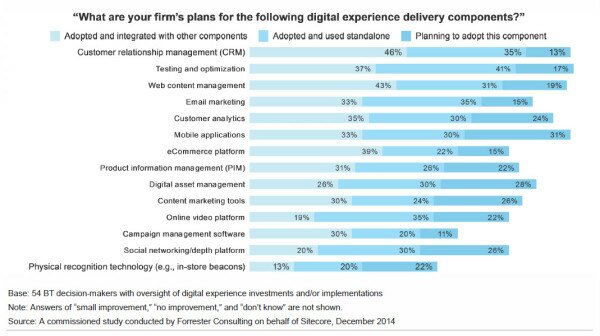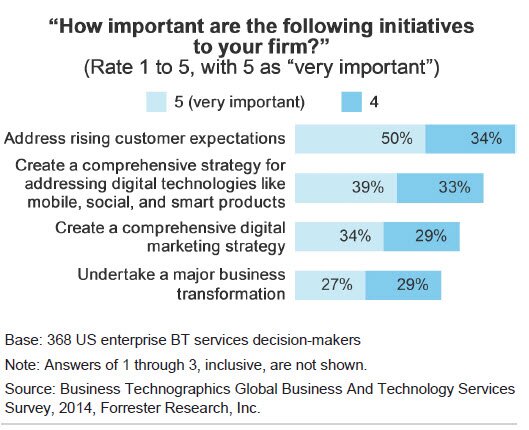Forrester Examines Digital Experience Challenges and Priorities: Yes, They Do Exist
by Barb Mosher Zinck | March 13, 2015 12:23 pm
A sponsored Forrester research brief crossed my desk related to the challenges organizations face implementing digital experiences and I thought I would share some highlights with you (please note the paper is sponsored by Sitecore).
There’s much in this brief we’ve heard before, but bares repeating because although we all understand that digital transformation needs to happen now, it’s a lot easier to say it than it is to do it. And it doesn’t matter what size company you have, it’s going to take a lot of effort.
The customer drives most of what companies do today. Technology has enabled this through making information more readily accessible. Information that helps them do research and make decisions, sometimes long before they even approach an actual product sales person. Unfortunately many companies aren’t prepared to work with a customer journey that is no longer linear in nature and that is increasingly digital (and mobile).
But companies do acknowledge they need to start making changes. Sixty-three percent of those surveyed said that developing a digital marketing strategy rates a 4 or 5 on a scale of 5, and that business transformation initiatives rate at 56% importance. You’ll also note in the chart below that addressing rising customer expectations ranks number one in importance – everything else really reflects that priority.
A solid digital experience start is not just about generating brand awareness though. According to Forrester it also supports customer lifetime value (CLV), topline revenue, retention and conversion rates. And of course there are cost improvements to things operations such as customer service and marketing.
The Key Digital Experience Technologies
Forrester identifies fourteen key technologies for digital experience. They are listed in the chart below and range from web content management, digital asset management, email and content marketing, e-commerce, mobile and location technologies.
 These are all great technologies to improve digital experiences, but the problem is they are often used in a siloed manner. In fact the number one stated barrier to digital experience is the lack of integration of the technologies used in a company. The second barrier is the siloed nature of content. In addition, many companies have more than one customer database. All of these challenges, together with organizational issues (siloed departments, inability to collaborate easily, etc..) can lead to a poorly executed digital experience strategy.
These are all great technologies to improve digital experiences, but the problem is they are often used in a siloed manner. In fact the number one stated barrier to digital experience is the lack of integration of the technologies used in a company. The second barrier is the siloed nature of content. In addition, many companies have more than one customer database. All of these challenges, together with organizational issues (siloed departments, inability to collaborate easily, etc..) can lead to a poorly executed digital experience strategy.
Which leads us to the priorities companies note. Integration is obviously a key one – for business systems, for content and for customer data. Another is flexible deployment options. Many companies are seeking cloud-based alternatives to help them deliver digital experiences quicker, or at least some aspects, but still have that necessary integration with other systems that may not be cloud-based.
Finally, it’s not a good time to sit still and just focus on what’s happening today. Companies need to stay active in monitoring the market because new customer touchpoints are always popping up, as others may fade away. Any digital experience strategy requires the ability to anticipate what’s coming. And that may be the most challenging thing for companies today.
Note: The data Forrester uses for this brief comes from Business Technographics Surveys and a custom survey of 54 US business technology decision makers.
Share and Enjoy
Source URL: https://digitaltechdiary.com/forrester-examines-digital-experience-challenges-and-priorities-yes-they-do-exist/1663/
